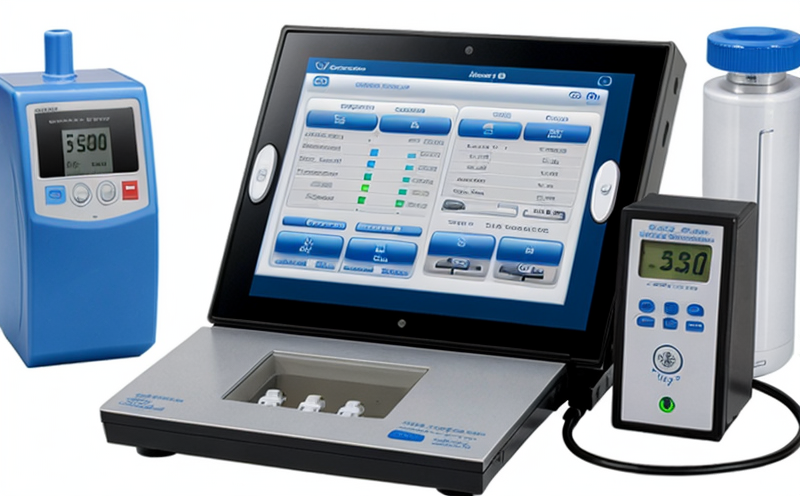Air-in-Line Detector Performance Testing
In the realm of medical devices, particularly infusion pumps and drug delivery systems, ensuring patient safety is paramount. An essential component in safeguarding patients from potential risks associated with air embolisms is the air-in-line detector (AIDL). This device plays a crucial role by continuously monitoring the flow path for any presence of air bubbles that could compromise treatment efficacy or lead to harmful complications.
The performance testing of AIDLS is critical in verifying their reliability and compliance with international standards, which ensures they function correctly under various operational conditions. Compliance with these standards not only supports regulatory approval but also enhances trust between healthcare providers and patients regarding the safety and effectiveness of medical devices.
Our laboratory specializes in providing comprehensive air-in-line detector performance testing services tailored specifically for this sector. This includes a range of tests designed to assess the detector's ability to accurately identify bubbles within specified ranges, maintain consistent detection rates across different flow rates, and operate effectively over extended periods without degradation or failure.
The process begins with thorough instrumentation setup, where we utilize calibrated equipment capable of simulating real-world scenarios. Specimens are carefully prepared using known concentrations of air bubbles to mimic the conditions encountered during actual use. These tests evaluate not only the detector's sensitivity but also its specificity, ensuring it does not produce false positives or negatives.
After testing, detailed reports are generated outlining each test result alongside compliance with applicable standards such as ISO 80601-2-7 and IEC 60601-2-5. These documents serve multiple purposes including internal quality assurance, external audits by regulatory bodies, and providing evidence for product certification.
Our team of experienced professionals employs rigorous methodologies to ensure accurate testing results. By leveraging advanced technologies and adhering strictly to best practices, we strive to deliver reliable data that can be trusted when making decisions about the safety and performance of medical devices.
Applied Standards
The air-in-line detector (AIDL) performance testing follows strict adherence to relevant international standards. These guidelines provide a framework for ensuring consistent quality across different manufacturers and regions. Some key standards include:
- ISO 80601-5-1:2017 – This standard covers the design, manufacture, and labeling of medical electrical equipment used in infusion therapy.
- IEC 60601-2-4:2013 – Focuses on electromagnetic compatibility requirements for basic safety and essential performance.
- ASTM F2792 – Provides a method for determining the presence of air bubbles in intravenous solutions.
Compliance with these standards ensures that our testing results are credible and universally accepted, meeting both local regulatory requirements and international expectations. It also helps manufacturers demonstrate their commitment to producing safe and effective medical devices.
Scope and Methodology
The scope of air-in-line detector performance testing encompasses several key areas critical for evaluating the device's functionality:
- Detection Sensitivity: Testing whether the AIDL can detect air bubbles at specified concentrations.
- Specificity: Ensuring that only genuine air bubble signals trigger an alarm or signal, avoiding false positives.
- Response Time: Measuring how quickly the detector responds to changes in the flow path.
- Longevity: Evaluating the stability of the detector over time and under varying conditions.
- Integration Compatibility: Assessing the ease with which the AIDL integrates into existing medical systems without causing disruptions.
The methodology involves using a controlled environment where we can simulate various operational conditions. This includes setting up different flow rates, changing temperature and humidity levels, and introducing varying concentrations of air bubbles. Each test is conducted multiple times to ensure consistent results.
Data collected during these tests are analyzed meticulously, comparing them against established criteria outlined in the applicable standards. Any deviations from expected outcomes are investigated thoroughly until satisfactory performance is confirmed. This approach guarantees that every aspect of the AIDL's operation meets stringent quality benchmarks.
Use Cases and Application Examples
AIR-IN-LINE DETECTOR PERFORMANCE TESTING IN INFUSION PUMPS & DRUG DELIVERY SYSTEMS:
- Real-time Monitoring: Continuous monitoring ensures that air embolisms are detected immediately, preventing serious complications.
- Patient Safety: Detecting and alerting staff to the presence of air bubbles helps protect patients from potentially life-threatening situations.
- Regulatory Compliance: Ensuring adherence to international standards enhances credibility in global markets.
- R&D Support: Providing insights into device performance under different conditions aids in refining designs and enhancing features.
In summary, the air-in-line detector plays a vital role in safeguarding patient health by continuously monitoring for any signs of air bubbles. Our specialized testing services provide crucial data supporting this critical function, ensuring that medical devices meet the highest safety standards.





